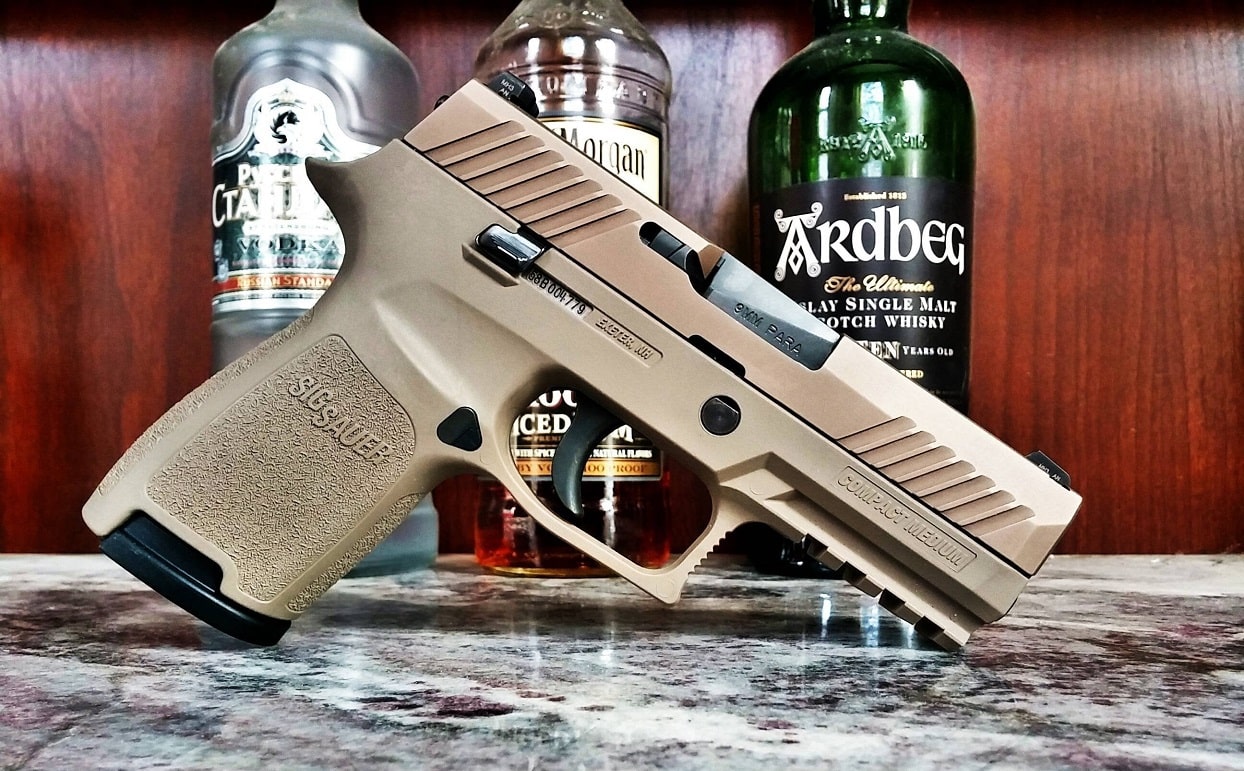Sig Sauer P320 Compact, a Short Review: The Sig Sauer P320 Compact is a modular-framed, striker-fired pistol designed for versatility and customization. It’s got a lot of interesting features and supports the Sig Sauer reputation for reliable and quality firearms. But is it worth buying? The U.S. Army bought a ton of these for service in a full-sized capacity–of course, heavily modified for combat conditions. Here’s what we can tell you.
Accuracy
This gun is very accurate. Right out of the box, the P320 averages 1.5-inch groupings at anywhere from 7 to 25 yards, slow-fire. There is very little recoil, which is surprising considering it can feel a little top-heavy until you get used to it. You may have to allow yourself some time to adjust to the 6’oclock hold as well, especially if you are used to shooting with a more angled grip, like with a Glock. The photoluminescent sights provide an accurate sight picture and allow for precise shooting in low-light situations. The RX model also comes with a great red dot optic, Sig’s Romeo 1.
Reliability
The Sig P320 is amazingly reliable. After over 500 rounds and a wide variety of ammo—including Hornady TAP, Winchester White Box, and Blazer Brass FMJ—there were no misfires or jams. Testing out all the frames with hollow and plink ammo has proven you can count on this gun to fire consistently and without issue.
Handling
I really like how the P320 handles. It’s lightweight, if a little top-heavy, and is easy to maneuver between targets. The RX Carry model is great for concealed carry, and the potential for customization on this pistol means it can be customized for almost every shooter’s needs. The P320 is a technically a chassis gun with a series of interchangeable grip frames or a Sig X-change kit. You can change out the caliber, barrel, grip, and slide for the entire series—excluding the .45 ACP—to fit your needs and specifications. So, if you don’t like the grip, or decide you want a to try out another caliber, the P320 provides an alternative to buying a completely different gun. Even with all the customizations available, the P320 remains fairly simple in its design. The magazine release is reversible, the slide lock and disassembly lever are easy to use and there isn’t an external safety.
Trigger
The trigger seems to be the only point of contention for the Sig P320. As far as I’m concerned, it’s just going to come down to preference. The trigger on the P320 is a wide, single-action trigger that breaks cleanly at around 5.5 pounds with a smooth reset. There’s no stacking and some overtravel that could affect accuracy, so you may have to make some adjustments if the trigger isn’t a fit for you.
Magazine & Reloading
Sig Sauer packages these guns with two 15-round mags for the compact model and 17-round mags for the carry. These steel mags are easy to load and smoothly drop free when released. Another great thing about the P320 is that its magazines are exchangeable with the P250.
Length & Weight
The P320 is only 7.2-inches in overall length, 5.3 inches tall, and 28 oz when loaded. It’s small, compact, and has a sleek design. No matter your application, this gun won’t weigh you down.
Recoil Management
The high, vertical grip, high bore axis, and undercut trigger guard all contribute to excellent recoil management in the P320. With the custom grip models available, there’s no reason you should have trouble keeping an accurate sight picture between shots or have the gun jerk out of your grip.
Price
The P320 runs for about $500 retail (Pre-Covid), depending on the model. The X-Change kits sell from Sig Sauer for around $450 and the grip frames for about $45.
My Verdict?
The Sig Sauer P320 Compact is a great gun for anything from concealed carry to competition shooting. It’s accurate, reliable, and primed for customization. If you are looking for a unique and dependable handgun, you can’t go wrong with the P320.
Richard Douglas is a firearms expert and educator. His work has appeared in large publications like The Armory Life, Daily Caller, American Shooting Journal, and more. In his free time, he reviews optics on his Scopes Field blog.

